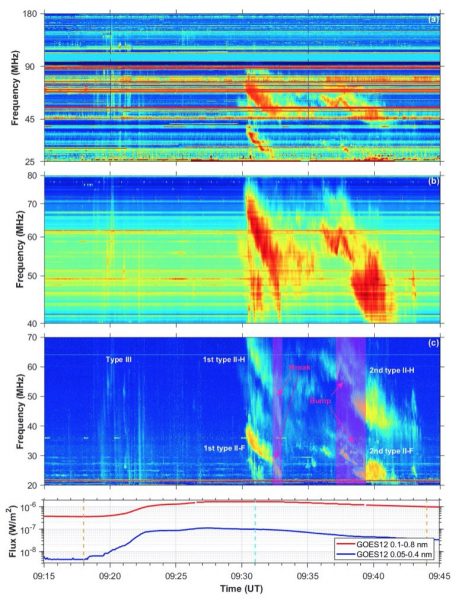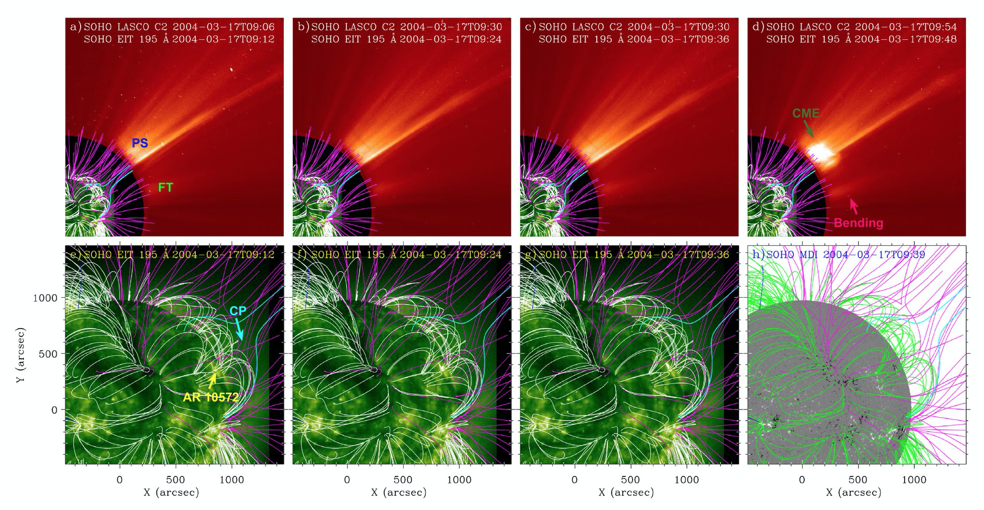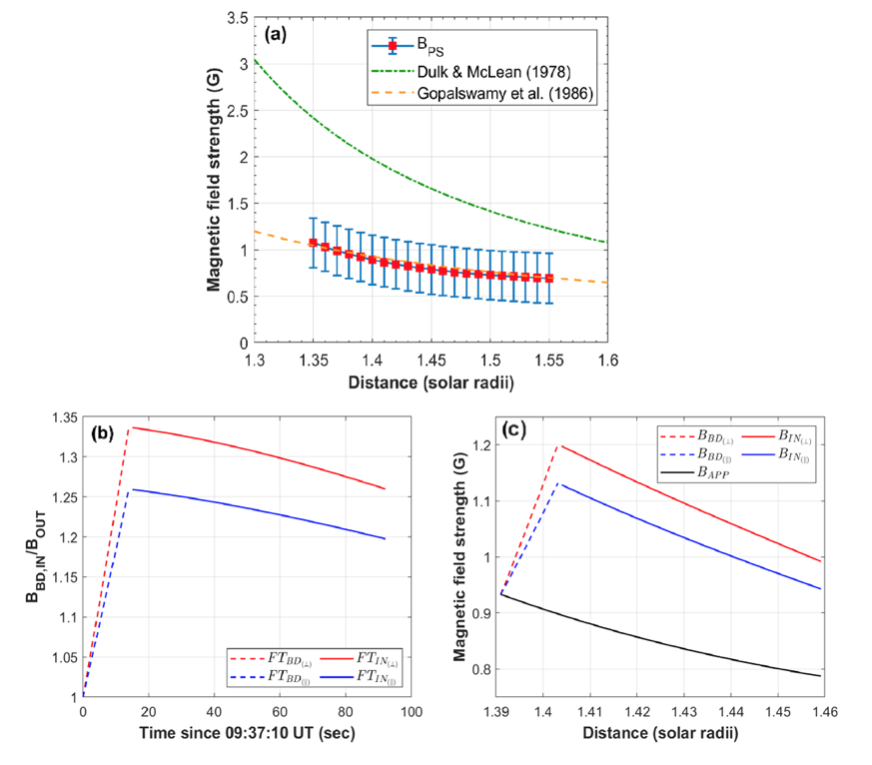The magnetic fields of the Sun govern the solar corona structure where the solar wind emanates and further accelerates supersonically. Therefore, the accurate observational data about the topology, and more significantly, quantities of the coronal magnetic field are pivotal for identifying the solar wind sources as well as for the Space Weather modeling where these data specify initial conditions. Magnetic-field strength values in the solar wind sources are derived from various solar space- and ground-based observations, but, so far not accounting for specific types of radio bursts. These are “fractured” type II radio bursts (Kong et al., 2012; Feng et al., 2013). These bursts, exhibiting spectrally indented shapes in the form of bumps or breaks, are the most spectacular and unexplored yet. They are attributed to the collisions of shock waves with coronal structures (so far only streamers), being solar wind sources. Here, we report about radio observations of two “fractured” type II bursts to demonstrate a novel tool for probing of magnetic field variations in the solar wind emitters.
Data Analysis and Results
In our research, we have recognized two successive type II solar radio bursts with the specific morphology recorded in meter-decameter radio observations on March 17th, 2004 (see Fig. 1). In fact, in both the bursts there is a collection of spectral features. While the first type II burst has the spectral break, the second type II burst has the spectral bump, and moreover both type II bursts show the band-splitting. The band-splitting analysis allows ones to provide diagnostics of magnetic fields in the solar corona (Vršnak et al., 2002). We made a multi-band analysis of observations from Large Angle and Spectrometric Coronagraph Experiment (LASCO) and Extreme ultraviolet Imaging Telescope (EIT) on Solar and Heliospheric Observatory (SOHO) spacecraft, as well as to the Potential-Field Source-Surface (PFSS) model for getting the geometry of magnetic field lines (see Fig. 2).
The joint analysis of spectral and imaging measurements has allowed us to unequivocally identify coronal structures in the solar atmosphere responsible for the bursts’ features in dynamic spectra. It was established that both “fractured” bursts were produced by the same shock caused by the coronal mass ejection (CME) after C1.6 class solar flare from the active region (AR) 10572. The AR was located under the pseudo-streamer (PS), so the rising CME/shock penetrated into the PS from the photosphere that resulted in occurrence of the spectral break in the first type II burst. The spectral bump feature in the second type II burst emerged from the sideward passing of the same shock wave through the nearby flux tube (FT). The last finding should be regarded as a novelty, since this designates FTs as coronal structures influencing the propagation of shock waves in the solar corona. So far, the type II spectral bump has been attributed to the propagation of a shock wave across a streamer stalk from one side to another.

Figure 1. Collection of the time-aligned solar dynamic spectra with the IZMIRAN radio observatory (Troitsk, Russia) (a), the AIP radio spectropolarimeter (Tremsdorf, Germany) (b), the Nançay Decametric Array (Nançay, France) (c) on March 17th, 2004. The fundamental (F) and harmonic (H) components of fractured type II bursts are labeled on the NDA spectrogram, where the semitransparent regions indicate approximate durations of break and bump spectral features. A group of type III bursts is denoted. The lower panel is the solar X-ray emission measured by GOES 12 on that day. The C1.6 class flare start/end and peak times are pointed by orange and cyan dashed vertical lines, respectively. The common time axis is in the range 09:15-09:45 UT.
Using the pre-break band-splitting from the type II event with spectral break, we calculated the magnetic field value in the lower part of the PS, namely below its cusp point. The obtained values are consistent well with the Gopalswamy model of magnetic field (see Fig. 3(a); Gopalswamy et al., 1986). It is important to note that the band-splitting structure of the second type II burst was lasting before and during the spectral bump, that was observed for the first time. Suffering from large uncertainties in determination of the shock speed during the second type II event, we derived the ratio of the magnetic field inside-to-outside (BIN/BOUT) of the FT (see Fig. 3(b)). To get the absolute magnetic field magnitudes inside the FT, we have applied an original calibration procedure. The variation of the magnetic field obtained from the type II event with spectral break was employed for normalization of the BIN/ BOUT ratio, since both fractured type II bursts occurred within overlapping ranges of heights in the corona (see Fig. 3(c)).

Figure 2. Magnetic field configurations obtained from the PFSS model based on the measurements from the SOHO MDI for the Carrington Rotation 2014. In panels (a-g) field lines are superimposed on SOHO LASCO C2 and SOHO EIT 195 Å images, where the closed field lines are colored in white, while inward (outward) field lines are pictured in purple (blue), respectively. In panel (h) the SOHO MDI magnetogram at 09:39 UT shows the magnetic regions of the south (dark color) and north (white color) polarity on the photosphere, where the closed field lines are colored in green, while colors of outward (inward) field lines correspond to the ones in panels (a-g). In panel (a) labels identify structures as the pseudo-streamer (PS) and the flux tube (FT). The site of the NOAA active region (AR) 10572 is pointed by the yellow arrow in panel (e). There an approximate location of a cusp point of the PS is indicated by the cyan arrow. In panel (d) the pink arrow denotes a visible bending of the FT caused by the CME passage; compare with panel (c).

Figure 3. (a) Magnetic-field strength at a lower part of the pseudo-streamer, BPS, namely below its cusp point, as a function of distance from the photosphere. The green and orange lines correspond to the coronal magnetic field models of Dulk & McLean (1978) and Gopalswamy (1986), respectively. (b) Magnetic-field strength ratios in the FT’s boundary and inside. (c) The absolute magnetic-field values in the FT’s boundary and inside. The dark solid curve represents the approximation of the magnetic field values within the distance range of 1.391-1.459 Rʘ obtained by the examination of the first “fractured” type II burst.
Conclusions
For the first time, we have obtained the magnetic-field strength in the PS and FT by the examination of the band-splitting structure of “fractured” type II bursts. Foremost, the magnetic field inside a FT has been determined from radio observations. These results cope with a relevant task in the solar radio astronomy – measurements of magnetic field in the coronal structures in a routine way. There are several semi-empirical extrapolation models exploiting photospheric field maps to estimate the coronal field typically up to 2.5 solar radii (Wang & Sheeley, 1992; Abbo at al., 2015). These models cannot reconstruct the exact magnetic configuration of the corona. They only provide an approximation of the global magnetic topology. In this connection, the type II bursts, showing the band-splitting and distinctive fractured shapes, can be as probing signals to get the magnetic-field strength in different coronal structures acting on the solar wind.
Based on a recently published article:
A. Koval, M. Karlický, A. Stanislavsky, B. Wang, M. Bárta, and R. Gorgutsa (2021). Shock-wave radio probing of solar wind sources in coronal magnetic fields, Astrophysical Journal, 923, 2 DOI: 10.3847/1538-4357/ac2f3f
References
Kong, X. L., Chen, Y., Li, G. et al., 2012, ApJ, 750, 2
Feng, S. W., Chen, Y., Kong, X. L. et al., 2013, ApJ, 767, 1
Vršnak, B., Magdalenić, J., Aurass, H., & Mann, G., 2002, A&A, 396, 673
Gopalswamy, N., Thejappa, G., Sastry, C. V., & Tlamicha, A., 1986, BAICz, 37, 115
Wang, Y.-M. & Sheeley, N. R., Jr., 1992, ApJ, 392, 310
Abbo, L., Lionello, R., Riley, P. & Wang, Y.-M., 2015, SoPh, 290, 2043
*Full list of authors: A. Koval, M. Karlický, A. Stanislavsky, B. Wang, M. Bárta, and R. Gorgutsa
